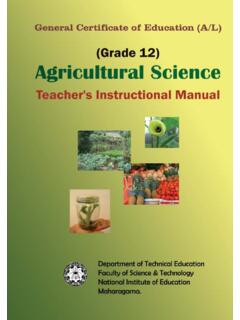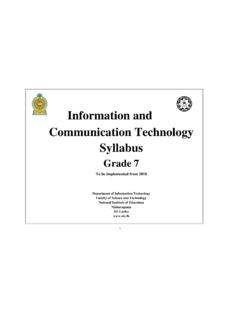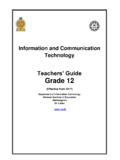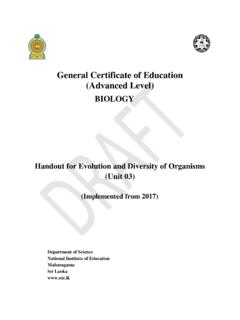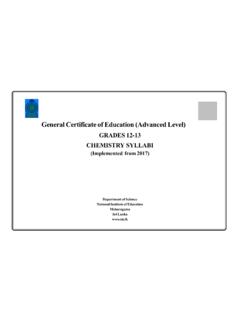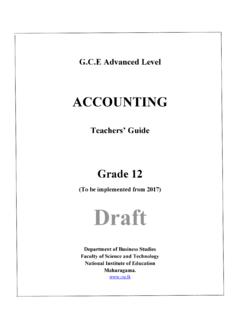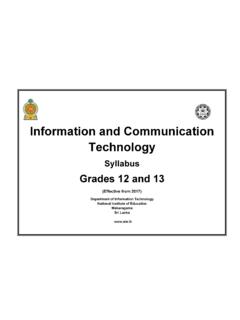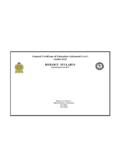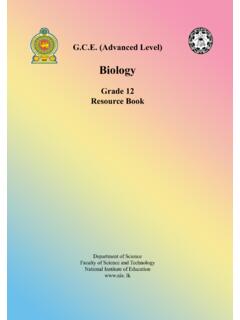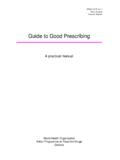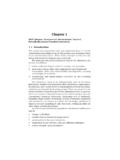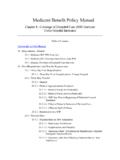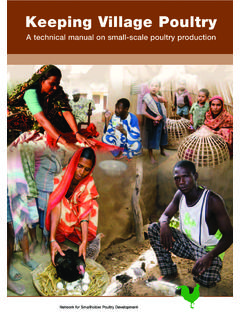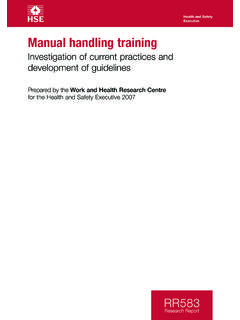Transcription of Biology Practical Instructional Manual - NIE
1 (Advanced Level)BiologyPractical Instructional Manual (for the syllabus implemented from 2009)Department of Science, Health and Physical EducationFaculty of Science and TechnologyNational Institute of (Advanced Level)BiologyPractical Instructional Manual (for the syllabus implemented from 2009) National Institute of Education1st Print - 2011 Department of Science, Health and Physical EducationFaculty of Science and TechnologyNational Institute of Education-iiGuidanceProf. Abeyrathne Bandara, Director General,National Institute of Education (NIE)Mr.
2 Lal Wijesinhge Assistant Director General(Curriculum Development), NIED irectionMr. Anthony, Director,Department of Science, Health and Physical Education, NIES ubject Coordination:Ms. Mapagunaratne , Project Officer, NIER esource contribution: Internal :Mr. C. Anthony-Director, Department of Science, Health& Physical Mapagunaratne-Project Officer, NIEMs. Wijesekara-Assistant Project Officer, NIE External :Prof. Widanapathirana-Senior Professor, Department ofMicrobiology, University of KelaniyaProf. Wijeratne-Senior Professor,Department of Zoology, University ofKelaniyaMs.
3 Shirani Devotta-Dhammissara College,NattandiyaMs. Perera-Sirimavo Bandaranayake B. , ColomboMs. Abeykoon-St. Anthonys Girls School, KandyMs. Bandara-Dharmaraja College, KandyMs. Basnayake-Ku/ St. Annes College, KurunegalaMs. Hanee-K/ Zahira College, GampolaMs. Nishadi Kulathilaka-Maliyadeva Girls School, KurunegalaMs. C. R. Dias-St. Thomas College,Mt. LaviniaMs. B. Ganeshadas-Colombo Hindu College,RatmalanaMr. Pathirana-Vijitha Central College, Perera-Devi Balika Vidyalaya,ColomboType Setting :Ms.
4 Pathirana- NIEWeb Site )Parts and functions of the microscope , and using microscope toobserve )Simple laboratory tests for the identification of reducing andnon-reducing sugars ,starch ,proteins ,fats and )Use of electron micrographs to understand the structure ofcellular )Microscopic observation and identification of different types ofplant )Microscopic observation and identification of different types ofanimal )Identification of different stages of mitosis and meiosis usingmicroscopic )Laboratory experiment to demonstrate enzyme activity and todetermine the rate of enzymatic reaction ( starch - amylase).
5 088)Determination of rate of photosynthesis by amount of oxygen )Determination of rate of respiration using germinating )Observation of the characteristic features of typical Bacteriaand ) Observation of the characteristic features of typical organisms of phylaCiliophora, Rhizopoda, Bacillariophyta, Phaeophyta,Rhodophyta & )Observation of characteristic features of typical organisms of , Zygomycota, Ascomycota and )Observation of characteristic features of typical organisms of phyla Bryophyta,Lycophyta, Pterophyta, Cycadophyta, Coniferophyta, Anthophyta and classesMonocotyledoneae and )Observation of characteristic features of the phyla Coelenterata, Platyhelminthes,Nematoda,Annelida, Mollusca, Arthropoda and Echinodermata and the externalfeatures of the typical organisms belonging to the classes of each of these phylaexcept )
6 Observation of characteristic features of typical organisms of classesOsteichthyes, Chondrichthyes, Amphibia, Reptilia, Aves and )Study the basic histological structure of the alimentary canal of man andrelates the major variations in different regions to their )Study of human respiratory system using models/diagrams andobservation of effects of exercise on respiratory rate and pulse )Determination of solute potential of epidermal peels of )Determination of water potential of Colocasia petioles / Potato )Determination of rates of transpiration from leaves and )Study the circulatory system of man using specimens/ )Study of patterns of nervous systems in animals using models/ diagrams/ charts2723)Study of selected sense organs of animals using diagrams / models )Study the structure of the human eye and ear using diagrams /models/ charts2925)Study of major types of excretory organs in animals usingmodels/diagrams and )
7 Study of the gross structure of the human skull and vertebral column to the functions of the various parts using models / diagrams /specimens3027)Study of the human pectoral and pelvic girdles and appendicularskeleton using specimens/ models/ )Microscopic examination of cross sections of root , stem and )Study of male reproductive system using models or )Study of female reproductive system using models or )Study of cross section of primary stem and primary root of a Monocotand a )Microscopic and macroscopic examination of secondary structure ofDicotyledonous )Study of inheritance of some common Mendelian )Study of a small ecosystem and finding out the organization levelsof the )Identification of different types of microorganisms and observation ofbacteria and )Practice techniques for sterilization of water, culture media, glassware,heat labile substances and inoculating )Preparation of a simple culture medium (Nutrient Agar) and inoculationwith a sample of toddy/ )
8 Staining of bacteria found in toddy or yoghurt using a simple stain(Methylene Blue)..4439)Identification of fish, prawn and aquatic plant species used in )Study of common insect pests paddy and coconut in Sri )Observation of staes of life cycles and study of data on incidence anddistribution of the following parasites in Sri Lanka: malarial parasite,filarial parasite and )Study of different kinds of weeds in a selected area and separation and functions of the microscope, and using microscope to observe Learning the parts and understands the functions of a student the microscope in the correct wet mounts of live tissues or the microscope to observe the magnification of cells according to the appropriate size and the the actual size of and Equipments Simple student microscope with low.
9 Medium and high power objectives Clean dry slides and cover slips Beaker and watch glasses/ Petri dishes Water sample from paddy field, hay infusion , pond water sample, onion epidermalpeel Paint brush and a razor blade Graph paperInstructions Instruct the students to follow the guidelines given below. Identify the major parts of the microscope: The body and base, ocular tube,eyepieces (interchangeable), rotatable objective holder, low, medium and highpower objectives, (which can be screwed in), focusing knobs-coarse and finefocus, stage with center circular opening, stage clips, adjustable mirror.
10 Observe the samples employing proper microscopic techniques. Make thin epidermal peels of onion and place in water in a watch glass orPetri dish. Transfer section of onion peel into a drop of water on the center of a cleanglass slide by using a fine paint brush. Hold the cover slip at the edge of the drop of water, with the help of amounting needle, and gently lower the cover slip, supporting it with the needleonto the drop of water. Do not allow air bubbles to be trapped under thecover slip. Place the slide on the stage of the microscope and move the low powerobjective in to Looking through the eye piece, move the slide to bring the object into position forstudy.
